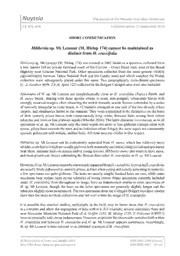
Hibbertia sp. Mt Lesueur (M. Hislop 174) cannot be maintained as distinct from H. crassifolia PDF
Preview Hibbertia sp. Mt Lesueur (M. Hislop 174) cannot be maintained as distinct from H. crassifolia
XXXX 475 Nuytsia The journal of the Western Australian Herbarium 23: 475–476 Published online 17 September 2013 SHORT COMMUNICATION Hibbertia sp. Mt Lesueur (M. Hislop 174) cannot be maintained as distinct from H. crassifolia Hibbertia sp. Mt Lesueur (M. Hislop 174) was erected in 2002 based on a specimen collected from a low, laterite hill on private farmland south of the Coorow – Green Head road, west of the Brand Highway near Lesueur National Park. Other specimens collected from the same general vicinity (approximately between Tathra National Park and the Cataby area) and which matched the Hislop collection were subsequently placed under this name. Two geographically more-distant specimens (C. A. Gardner 8698, T.E.H. Aplin 122) collected in the Bolgart-Calingiri area were also included. Specimens of H. sp. Mt Lesueur are morphologically close to H. crassifolia (Turcz.) Benth. and H. aurea Steud., sharing with these species obtuse to acute, non-pungent, tuberculate leaves with strongly recurved margins often obscuring the midrib beneath, sessile flowers subtended by a series of narrowly triangular to ovate bracts, 8–12 stamens arranged on one side of the two densely pilose carpels, and staminodes lateral to the stamens. They were considered to be distinctive on the basis of their sparsely pilose leaves with conspicuously long, white, flexuose hairs arising from robust tubercles and more or less glabrous sepals (Wheeler 2004). The latter character is erroneous, as in all specimens of H. sp. Mt Lesueur only the outer sepals are more or less glabrous (though often with sparse, pilose hairs towards the apex and an indistinct ciliate fringe); the inner sepals are consistently sparsely pubescent with minute, stellate hairs. All three taxa are similar in this respect. Hibbertia sp. Mt Lesueur can be consistently separated from H. aurea, which has relatively more slender, acute leaves which are usually glabrous both at maturity and when young (occasional specimens bear short, uncinate hairs on mature and/or young leaves). Hibbertia aurea also tends to have more, and more prominent, bracts subtending the flowers than either H. crassifolia or H. sp. Mt Lesueur. However, H. sp. Mt Lesueur cannot be consistently separated from H. crassifolia. Leaves in H. crassifolia are usually finely pubescent to sparsely pilose, at least when young and usually persisting to maturity; a few specimens are quite glabrous. The hairs are mostly simple; hooked hairs are rare, while some specimens bear stellate hairs on the tubercles of young leaves. Many specimens currently included under H. crassifolia, from throughout its range, have an indumentum similar to most specimens of H. sp. Mt Lesueur, though the hairs on the latter specimens are generally slightly longer and the tubercles slightly more pronounced. The two specimens from the Calingiri-Bolgart area have shorter hairs than the more northern collections and fall well within the range of H. crassifolia. It is possible that detailed studies, particularly in the field, may in future show that H. crassifolia is a complex and allow the segregation of taxa within it. For example, several specimens from and near Alexander Morrison National Park (E.A. Griffin 2192, M. Hislop 2729, F. Falconer NWFF7) have an unusually soft, dense indumentum. However, at present the observable variation both within H. crassifolia and between H. crassifolia and H. sp. Mt Lesueur appears continuous. Accordingly, H. sp. Mt Lesueur is here reduced to an informal synonym of H. crassifolia. © Department of Parks and Wildlife 2013 ISSN 2200-2790 (Online) http://florabase.dpaw.wa.gov.au/nuytsia/ ISSN 0085-4417 (Print) 476 Nuytsia Vol. 23 (2013) Taxonomy Hibbertia crassifolia (Turcz.) Benth., Fl. Austral. 1: 25 (1863). Pleurandra crassifolia Turcz., Bull. Soc. Imp. Naturalistes Moscou 22(2): 5 (1849). Type: Nova Hollandia [Western Australia, 1844–1847], J. Drummond 4: 120 (holo: KW, n.v.). Hibbertia sp. Mt Lesueur (M. Hislop 174), Western Australian Herbarium, in FloraBase, http://florabase.dec.wa.gov.au [accessed 31 May 2012]. Specimens examined (previously ascribed to H. sp. Mt Lesueur). WESTERN AUSTRALIA: 8–10 miles [12–16 km] E of Calingiri along Wongan Hills Rd, 19 July 1980, T.E.H. Aplin 122 (PERTH); Big Soak Plains, Warradarge, 21 Sep 2005, F. Falconer NWFF7; W of Bolgart, 2 Oct. 1947, C.A. Gardner 8698 (PERTH); 8 km NE of Mount Lesueur, NE of Eneabba, 20 Sep. 1979, E.A. Griffin 2283 (PERTH); Vacant Crown Land, W of Coomallo Creek, E of Jurien, 24 July 1980, E.A. Griffin 2712 (PERTH); Wongonderrah Rd, W of Brand Hwy, SSE of Cervantes, 22 Nov. 1992, E.A. Griffin 7944 (PERTH); off Green Head – Coorow road, c. 3 km W of Brand Hwy, 19 Sep. 1995, M. Hislop 174 (PERTH); Big Soak Plain, 25 Aug. 2002, M. Hislop MH 2729, F. & J. Hort, D. & J. Williams (PERTH); S side of Jurien Rd East, 4.6 km W of junction with Brand Hwy, 9 Sep. 1999, J.W. Horn 2335 (PERTH); W side of Reserve Rd, 0.1 km N of its junction with Carnamah – Eneabba Rd, 25 Aug. 2001, J.W. Horn 4010 (PERTH). Acknowledgements I thank Mike Hislop and the editors of Nuytsia for comments on the manuscript and discussions regarding the taxa discussed in this paper. References Wheeler, J.R. (2004). An interim key to the Western Australian species of Hibbertia (Dilleniaceae). Nuytsia 15(2): 311–320. Kevin Thiele Western Australian Herbarium, Department of Parks and Wildlife, Locked Bag 104, Bentley Delivery Centre, Western Australia 6983 Email: [email protected]
